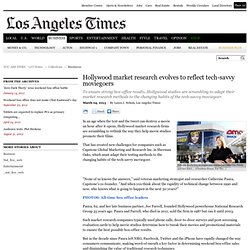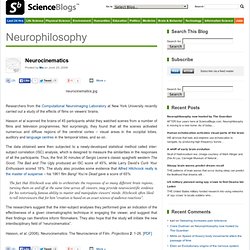

Hollywood market research evolves to reflect tech-savvy moviegoers. Veteran marketing strategist and researcher Catherine Paura and her sister,… (Christina House, For The…) In an age when the text and the tweet can destroy a movie an hour after it opens, Hollywood market research firms are scrambling to rethink the way they help movie studios promote their films.

That has created new challenges for companies such as Capstone Global Marketing and Research Inc. in Sherman Oaks, which must adapt their testing methods to the changing habits of the tech-savvy moviegoer. "None of us knows the answers," said veteran marketing strategist and researcher Catherine Paura, Capstone's co-founder. "And when you think about the rapidity of technical change between 1990 and now, who knows what is going to happen in the next 30 years? " PHOTOS: All-time box office leaders Paura, 62, and her late business partner, Joe Farrell, founded Hollywood powerhouse National Research Group 35 years ago. PHOTOS: Costliest box-office flops PHOTOS: Billion-dollar box office club. Rise of Neurocinema: How Hollywood Studios Harness Your Brainwaves to Win Oscars. One thing you aren't likely to hear Sunday night from the Oscar-winning producer after accepting the trophy for Best Picture: "I'd like to thank my neuroscience partners who helped us enhance the film's script, characters, and scenes.

" It's not that far-fetched, though. A sizable number of neuromarketing companies already brain test movie trailers for the major studios through fMRI, EEG, galvanic skin response, eye-tracking and other biometric approaches. For now, the test data helps the studios and distributors better market the movie. But what about using brain feedback to help make the movie? A trailblazing few firms and studios have delved into the upstart practice of "neurocinema," the method of using neurofeedback to help moviemakers vet and refine film elements such as scripts, characters, plots, scenes, and effects.
Stephen Susco, who wrote the $187 million grossing horror movie Grudge, is not a practitioner of neurocinema. Other filmmakers seem divided. Neurocinema, Neurocinematics. Is there a difference?

In The Neurocinema Collection™, we established that the term "neurocinema" doesn't really refer to movies with "Neuro" in the title or films about neurology. Instead, neuromarketers have have used the word in the following fashion: Neurocinema is a new filmmaking process that studies a viewer's sensorimotor, cognitive, and affective response to film stimuli. Researchers use technologies such as functional magnetic resonance imaging (fMRI) to measure changes in activity in parts of the brain,electroencephalography (EEG) to measure activity in specific regional spectra of the brain response, and/or sensors to measure changes in one's physiological state (heart rate, respiratory rate, galvanic skin response) to learn exactly what scenes excite or disinterest the viewer. There have been no peer-review studies on this methodology, only articles in the popular press (e.g., Wired.com and CNN.com).
In their Projections article, Hasson et al. (2008) state: Footnote 15. Neurocinematics – Neurophilosophy. Researchers from the Computational Neuroimaging Laboratory at New York University recently carried out a study of the effects of films on viewers’ brains.

Hasson et al scanned the brains of 45 participants whilst they watched scenes from a number of films and television programmes. Not surprisingly, they found that all the scenes activated numerous and diffuse regions of the cerebral cortex – visual areas in the occipital lobes, auditory and language centres in the temporal lobes, and so on. The data obtained were then subjected to a newly-developed statistical method called inter-subject correlation (ISC) analysis, which is designed to measure the similarities in the responses of all the participants.
Thus, the first 30 minutes of Sergio Leone’s classic spaghetti western The Good, The Bad and The Ugly produced an ISC score of 45%, while Larry David’s Curb Your Enthusiasm scored 18%. Hasson, et al. (2008). Uri Hasson - Neurocinematics: The Neuroscience of Film.